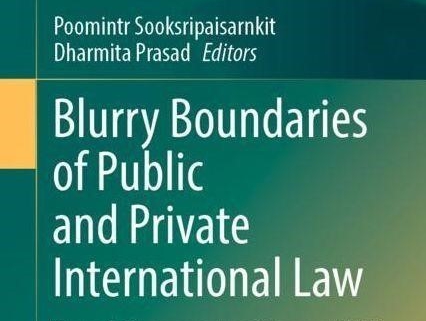New Book: Blurry Boundaries of Public and Private International Law
A new book entitled Blurry Boundaries of Public and Private International Law: Towards Convergence or Divergent Still? and co-edited by Dr Poomintr Sooksripaisarnkit (of the University of Tasmania) and Dharmita Prasad (Jindal Global Law School, O.P Jindal Global University) has just been released by Springer.
The description states that the book examines interactions and discusses intersectionality between public international law and private international law. With contributions from scholars from the USA, Canada, Australia, India, and the EU, this book brings out truly international perspectives on the topic. The contributions are arranged in four themes — Public international law and private international law: historical and theoretical considerations of the boundary; Harmonisation of private international law by public international law instruments: evaluation of process, problems and effectiveness; Case studies of intersectionality between public international law and private international law; and Future trends in the relationship between public international law and private international law.
The Foreword by Ralf Michaels is followed by these chapters:
Chapter 1: Public International Law and Private International Law: Setting scene for intersectionality – Poomintr Sooksripaisarnkit and Dharmita Prasad
Chapter 2 – Private International Law’s origins as a branch of the universal law of nations – Marco Basile
Chapter 3 – Recognition – A story of how the two worlds meet – Dulce Lopes
Chapter 4 – Forum non conveniens in Australia – how much weight should be given to comity? – Poomintr Sooksripaisarnkit
Chapter 5 – International rule of law and its relation to harmonisation – Dharmita Prasad
Chapter 6 – A quest for the missing link in the resolution of international investment disputes affecting host states’ citizens under public and private international law – Richard Mlambe
Chapter 7 – Visualising the role of international rule of law in claim funding by third parties – Gautam Mohanty
Chapter 8 – Article 79 CISG: Testing the effectiveness of the CISG in international trade through the lens of the COVID-19 outbreak – Nevena Jevremovic
Chapter 9 – Determination of legal effects of COVID-19 related export bans and restrictions on international sale of goods contracts: Interplay between public and private international law – Burcu Yuksel Ripley and Ulku Halatci Ulusoy
Chapter 10 – Private International Law vs Public International Law: Competing complimentary intersectionality in CISG Article 79? Peter Mazzacano
Chapter 11 – Blocking Statutes: Private individuals finding themselves in interstate conflicts – Marcel Gernert
Chapter 12 – When public international law meets EU private international law: an insight on the European Court of Justice case law dealing with immunity vis-à-vis the application of the Brussels Regime – Maria Barral Martinez
Chapter 13 – Children’s rights law and private international law: What do referencing patterns reveal about their relation? – Tine Van Hof
Chapter 14 – Ringfencing data? – Perspectives on sovereignty and localisation from India – Sai Ramani Garimella and Parthiban B
Chapter 15 – Private international law and public international law – increasing convergence or divergence as usual? – Poomintr Sooksripaisarnkit and Dharmita Prasad
For further details of the book please refer to the respective Springer webpage.
It is worthy of mention that the editors are in the process of planning an online “book launch” event at some point within the second quarter of 2022. Details once finalised will also be announced in this portal.



